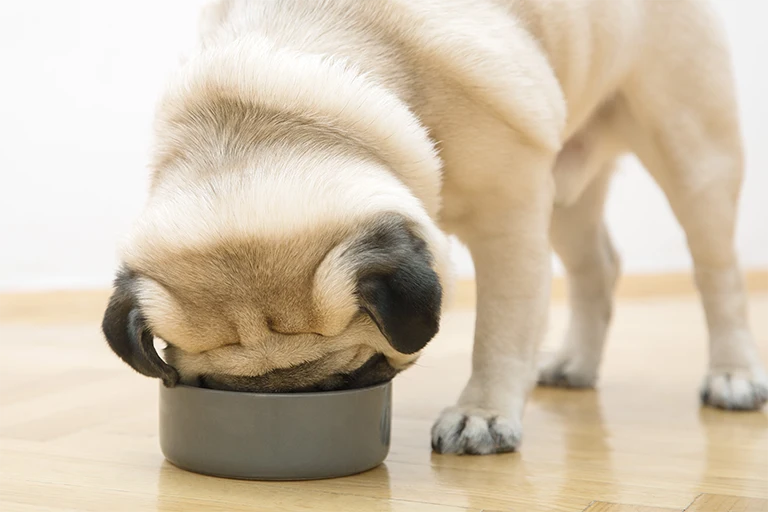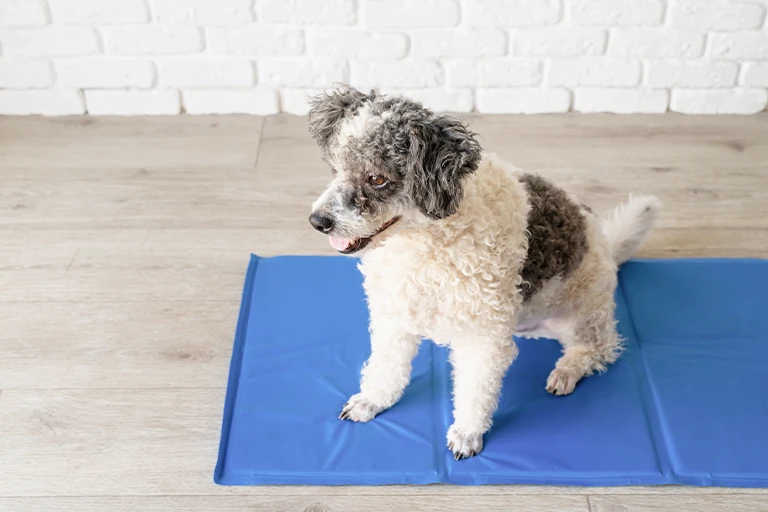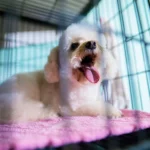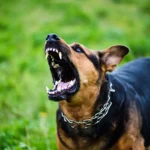Picking a dog bowl sounds easy?
But with so many choices out there, it’s easy to feel lost.
Right bowl is more than just a dish.
Please stay with me!
In this guide, we’ll break down the dog bowl maze.
Material Choices
Have you ever thought how much the material of your dog’s bowl matters?
It’s a big deal.
It affects hygiene, durability, and even your dog’s safety.
A top-notch bowl material?
It’s a game-changer: fresh food, lasting durability, and zero harmful chemicals for your dog.
Material is KEY.
Some are bacterial magnets.
Others? Allergy triggers. But don’t we all want a durable bowl that’s worth every penny?
Each material has its own superpower.
Stainless Steel Bowls: The All-Star. Why? They laugh in the face of rust.
Cleaning them? A breeze.
Bacteria? They don’t stand a chance. No wonder vets are fans.

Moving on, meet the Ceramic Bowls.
Chic, trendy, and oh-so-stylish. With countless designs, they’re the fashionistas of dog bowls. But, heads up: they can chip.
Regular checks are a must to keep things on the safe side.
Eyeing the budget side? Say hello to Plastic Bowls.
Light on the pocket and super light in weight.
Yet, always make a beeline for the BPA-free labels.
Chemicals? Not on our watch.
For those eco-champions out there, Bamboo Bowls are calling your name.
Durable? Check.
Stylish? Double-check.
A little advice: make sure they’re sealed tight. That way, they’re bound to last, making them a classy pick for your four-legged pal.
Perfect Size and Depth
Have you ever think about how your dinner plate affects your meal?
The same goes for your dog’s bowl.
The right size and depth ensure your dog eats comfortably.
They’re not just about the looks.
They’re about comfort, reduced mess, and healthy eating habits.
Here’s the deal: Just as you wouldn’t serve steak on a saucer, our friends need their “just right” dishware.
It’s not just a style; it’s about making every meal an event.
We’re talking Chihuahuas, Dachshunds, and the likes.
For these little guys, they like shallow bowls.
Why? Every bite is easily accessible.
Zero strain, all gains.
Think Golden Retrievers or German Shepherds.
These big munchers?
They need depth.
It’s all about fitting their mighty mouths.
But what about the unique squad?
The flat-faced crew like Pugs and Bulldogs?
Wide yet shallow bowls make every bite effortless.
So, no mealtime accidents.
A Dog’s Age Isn’t Just A Number. Puppyhood sees shallow dishes taking the front seat.
But as those puppy eyes grow older and their dietary needs shift, their bowl game should level up.
Depth, width – it all evolves as they journey from playful pups to graceful grown-ups.
Specialized Bowls for Unique Pooch Needs
Our companions aren’t just pets; they’re family.
And just like we need the right plate for our mealtime, our friends have their unique dining needs.
Sound intriguing?
Ever seen a dog eat like they’re in a food-eating competition?
Meet Max, the golden retriever.
But here’s a quick fix: slow-feeder bowls.
Crafted like mazes, they ensure dogs like Max take their sweet time eating.
The perk? Better digestion and less risk of bloating.
Picture Bella, the aging Labrador.
Age has given her wisdom but taken some spring out of her step.
Stooping low?
That’s a pain, literally.
Here’s where elevated bowls step in.
It offers her a comfortable height to enjoy her meals without any strain.
Now, think of Mr. Johnson.
Always on the clock, sometimes burning the midnight oil.
But Fluffy, his poodle, can’t wait that long!
Enter automatic feeders.
They’ll ensure Fluffy gets her timely meals.
Love a good adventure?
So does Sarah and her beagle buddy, Charlie.
Whether they’re hiking mountains or sunbathing on beaches, Charlie’s hunger doesn’t pause.
Solution?
Travel bowls.
Super portable and light, they ensure Charlie munches on time, every time.

Slow Feeder Dog Bowls
Does your dog treat every meal like a speed-eating contest?
Enter the slow feeder dog bowls: a game-changer for our dogs.
Meticulously crafted with intricate patterns and grooves, they turn a simple meal into an engaging puzzle.
Ever witnessed the aftermath of a speed-eating session?
Rapid eating can lead to a range of issues for dogs, from choking to digestive troubles.
And that’s precisely where slow feeder bowls swing into action.
Not only do they ensure a more measured eating pace, but they also bring a dash of fun, making every meal a delightful brain game.
Slow feeders guarantee each bite is savored.
This promotes digestion and keeping weight gain in check.
Right size does matter when selecting your dog’s slow feeder.
Too small or too large, and you’re back to square one.
Please make sure it complements your dog’s size.
Complexity is key.
From soothingly simple ridges to mind-bending mazes.
The world of slow feeders is vast.
The trick?
Gauge your dog’s patience and adaptability and choose accordingly.
While most slow feeders are crafted from plastic, stainless steel versions are available for those looking for durability and ease of cleaning.
These bowls are both sturdier and simpler to sanitize.
Cleaning is key. Some fancy bowl designs might be hard to clean.
Pick a bowl that’s easy for you, whether you wash by hand or use a machine.
Want to make mealtime fun?
Try slow feeders!
Mix in some healthy treats with their regular food.
It’s a tasty surprise for them and good for their health.
Elevated Dog Bowls
Elevated dog bowls are more than just a stylish choice.
They’re good for your dog’s health.
It also promotes better posture and aids digestion.
These bowls stand at the same level as your dog’s shoulder.
This helps them eat in a natural position.
Imagine eating from a plate on the ground.
Hard, right?
It’s the same for dogs.
Bowls on the ground can be hard for old dogs or dogs with pain.
Elevated bowls make it easier and safer for them.
Things to Remember:
The bowl should be at your dog’s shoulder level. Too high or too low isn’t good.
In terms of type, bowls come in different materials.
Wood looks nice. Metal is strong. Plastic is light.
But pick something that’s safe and won’t get chewed up.
The bowl stand should be stable. It shouldn’t tip over when the dog eats.
The bowl should come out easily so you can clean or fill it up.
Some high bowls have space underneath for food or toys. This can help keep things neat.
Elevated bowls help dogs eat comfortably and stay healthy.
When choosing one, think about its height, what it’s made of, and if it’s steady.
Also, check if it’s easy to use and clean.
Some bowls also have extra storage space for convenience.
Dog Bowl Mats

Dog bowl mats are more than just a cool thing to have. They help keep the eating area tidy and safe.
You can find some benefits of using dog bowl mats below:
The mats save your floors from water spots and food bits.
They stop bowls from moving around when the dog eats.
Cleaning up after meals is easier with a mat.
Here are some simple stories.
Lucy is a lively dog.
She pushes her water bowl everywhere.
A good mat made of rubber or silicone stops the water from spilling and is easy to clean.
Bruno is a big dog with big bowls.
His mat needs to be big too. A larger mat stops food and water from falling on the floor.
Sophie has three messy dogs.
She likes mats that are easy to clean.
Some mats can even be put in the washing machine.
That means more time to play with her dogs.
You can find Things to Remember Section below:
Make sure the mat is big enough for your dog’s bowls.
Mats with raised sides can stop food and water from going on the floor.
Pick a mat that’s easy to clean.
The mat shouldn’t slide around. It should stay in one place.
A dog bowl mat is like a big coaster for your dog’s bowls.
It keeps the feeding area clean and safe.
When picking a mat, think about its size, how easy it is to clean, and if it stays put.
Healthy Ways to Wash Your Dog’s Bowl
Just like we wash our dishes, we need to clean our pet’s bowls too. This helps to keep away bad stuff like bacteria.
This is important because less bacteria means a healthier dog.
Also, fresh food tastes better without old leftovers.
You can find How to Do It Right way below:
After feeding, always rinse the bowl with warm water to remove leftovers.
Twice a week, use a mix of water and white vinegar. It’s a great cleaner. No vinegar? Use a gentle pet-safe soap. And always use a separate brush just for your dog’s dishes to get into all the corners.
Please make sure no soap stays on the bowl. It’s not tasty or good for your dog.
Either towel-dry or let it air out. Remember, bacteria love wet places.
Once a month, soak the bowl in a bleach mix to kill strong bacteria. Scrub, rinse a lot, and dry.
If you use a ceramic bowl, look for cracks. For plastic ones, check for scratches. Both can hide bacteria.
A super clean bowl means a healthy dog.
Make cleaning a regular thing, and your furry friend will thank you.
FAQ
How can I select the right food bowl for my dog?
When it comes to buying a food bowl for your dog, size isn’t the only thing that matters.
Think about your dog’s eating style and the bowl’s material.
Here’s a brief rundown:
- Make sure your dog can easily eat from the bowl without straining.
- Got an excited eater? A non-slip bottom helps. If your dog tends to push their bowl, think about a weighted base.
In short, know your dog, and choose a bowl that fits their needs.
Which bowl material is most suitable for dogs?
Choosing a bowl’s material comes down to understanding your dog.
Here’s a snapshot:
- Stainless Steel: Tough, won’t rust, and cleans in a jiffy.
- Ceramic: Heavy (so it stays put) but can chip or break.
- Plastic: Lasts a while, but watch out if your dog likes to chew. Remember to clean often to keep bacteria at bay.
Know your dog’s habits and pick wisely!
How can I determine the appropriate bowl size for my dog?
Match your dog’s bowl size to their meal size.
Here’s a tip: measure their usual meal portion.
Then, pick a bowl that fits this with a bit of extra room up top.
Do dogs have preferences when it comes to bowls?
Dogs with longer noses might prefer deeper bowls, whereas flat-faced breeds might find shallow bowls more comfortable.
Which materials are considered healthiest for dog bowls?
Stainless steel is often considered one of the healthiest materials.
Because it’s non-porous and less likely to harbor bacteria.
Ceramic, when properly glazed, is also a good choice.
However, it’s essential to avoid bowls with paint or decorations that can chip off and be ingested.
Do veterinarians endorse stainless steel bowls for dogs?
Yes, many veterinarians recommend stainless steel bowls due to their durability and hygienic properties.
They’re resistant to rust and scratches. It is also easy to keep clean.
Are there dogs who dislike stainless steel bowls?
Some dogs find shiny stainless steel bowls a bit strange.
They might not like seeing their reflection or hearing the sound of their tags.
If this sounds like your dog, take it slow.
A simple trick? Put a mat under the bowl. It helps with the noise and feels more familiar.
Which is more advisable for dogs: plastic or metal bowls?
Metal bowls, especially those made of stainless steel, get a big thumbs-up.
Why? They last longer and stay cleaner.
Plastic bowls?
They can get scratchy, letting germs hide.
Plus, some dogs might get itchy from them or try to bite them.
Choose wisely for your dog!
What materials are deemed safest for dog bowls?
Stainless steel and ceramic bowls are top choices.
Why?
Smooth, and easy to wash.
If you pick ceramic, make sure there’s no lead.
For stainless steel?
Go for the best kind so it doesn’t get rusty.
Conclusion
Choosing a bowl for your dog isn’t just about eating.
From all the choices we talked about, which one caught your eye?
Which one do you want to try for your friend?
If you find this guide helpful, please sign up for our emails.
Got thoughts? Drop them in the comments below.
And please share it on social media.


